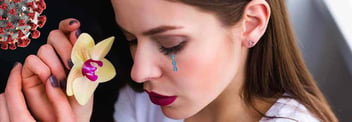Genetic Susceptibility to Childhood Trauma in the Age of Momo from the SLC6A4 “Orchid Gene” Well-Informed Parenting through a Simple Cheek Swab
- Home
- Blog

Dear Reader, if you have been following the news over the last few weeks, you are well aware of the challenges that parents are facing in protecting the innocence of their children. A pediatrician from Florida uncovered disturbing hidden messages in online programming typically catered towards young children, including instructions on how to kill yourself. While some have claimed it to be a hoax, the viral ‘Momo Challenge’ reportedly scared children into committing suicide, causing many schools across the country to send home precautionary warnings reminding parents to closely monitor children’s online viewing. The Momo Challenge is just one of many terrible features of the news cycle this week—and even if the Challenge is a hoax, other stories are horrifically real. Detailed documentaries emerged of celebrities reportedly sexually abusing minors, the first featuring graphic allegations of sexual abuse of underage females by R&B artist R. Kelly—and more recently, two men and their families depicting the paralyzing effects of alleged sexual abuse by the late pop music superstar Michael Jackson. Like many of my patients who are parents, you may be wondering how we can keep our kids safe from these real dangers and what factors might help us to assess and improve upon their resilience in the light of such atrocities.
Is Your Child an “Orchid” or a “Dandelion” when Subjected to Traumatic Experiences?
I have asked my valued colleague and friend, child psychiatrist Mark A. Novitsky Jr., M.D., to weigh in on childhood trauma and how genetic testing might help us to understand the impact that it can have on the growth and development of our children. As it turns out, one gene in particular, the SLC6A4 gene, may hold some important insights…
Could the SLC6A4 Gene Determine How Your Child Reacts to Trauma?
Welcome back Readers! Last week, we discussed the importance of the SLC6A4 gene in choosing an appropriate antidepressant medication when treating depressed or anxious youth. However, over the last several years, new research has emerged to suggest that the importance of this Serotonin Transporter (SERT or 5-HTT) gene, extends far beyond choosing a course of treatment. Today, we will discuss one powerful implication of SLC6A polymorphism: susceptibility to PTSD and depression in the face of trauma.
What we are really talking about here is altered stress response based on whether you have an SLC6A4 gene with short alleles (s/s), long alleles (l/l), or a hybrid (l/s). If you are a faithful reader of this blog like myself, you will recall Dr. Kehr’s elegant analogy of SLC6A4 variants as “orchids” or “dandelions” in the face of stress, noting that it’s our stress-response genes that determine which category we fall into. Individuals with two short alleles the SLC6A4 gene, when subjected to trauma, have increased serotonin in the amygdala, the fear-response center of the brain. This results in a higher likelihood of experiencing fear, greater release of cortisol, and ultimately potentially higher rates of anxiety and depression.
Much like the orchid flower, children with potential vulnerability (ie s/s genotype) flourish in a low stress, nurturing environment. “Dandelion” children (i.e. l/l genotype), on the other hand, are genetically better equipped to handle high-stress environments—like trauma.
Can You Change Your Child’s Genetic Destiny by Switching a Gene On or Off?
Now that you understand your child may be genetically predisposed to handle traumatic environments in a certain way, you may be wondering what, if anything, you can do to bolster your child’s resources. As Dr. Kehr says, DNA does not have to determine your destiny—and indeed, you can help alter your child’s genetic fate. Even though an individual may be more like that “orchid” (i.e. s/s), there are innumerable “epigenetic inputs” that can tell your body to switch “on” or “off” certain genes. In the case of trauma, the most valuable way that you can affect your child’s outcome is to provide a nurturing, non-judgmental environment.
In much the same way that a child with a broken bone may require a cast to prevent further damage and allow time for healing, it is critical for a child who opens up about trauma to experience emotional support to avoid further traumatization and start the healing process. What many parents don’t realize is the first critical step in the process toward healing happens the instant a child brings up a traumatic experience—and this often occurs well before a child presents for therapy. Sadly, it is not uncommon for a parent to initially deny that the trauma could have occurred or blame a child for putting themselves in that situation. It is important to recognize that a parent’s initial reaction can affect how a child’s body switches genes “on” or “off” at that very moment. Failure to empathize and provide support increases the likelihood of long-term devastating effects of trauma, including anxiety, depression, and suicidal behaviors.
Alternatively, providing a nurturing environment at home, in school, and through therapy can ensure a vulnerable “Orchid” can get the right mixture of “temperature, humidity, and nutrients” to not only persevere through the trauma but ultimately grow to be a strong, beautiful, resilient flower.
Related Information
- Learn about Genetic Testing
- Learn about Potomac Psychiatry
- Meet Our Doctors
- Contact Potomac Psychiatry
.png?width=144&height=144&name=Untitled%20design%20(34).png)



